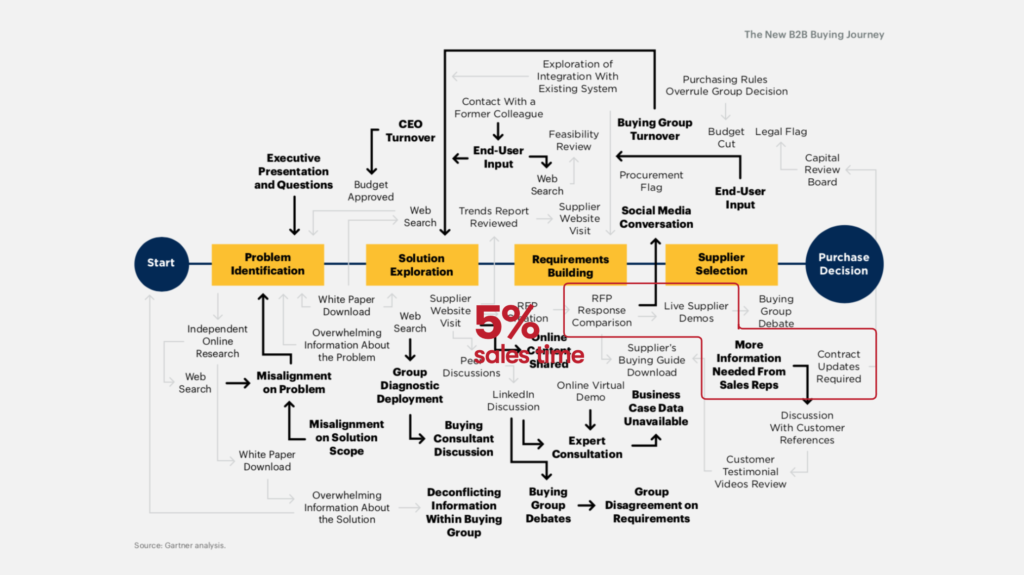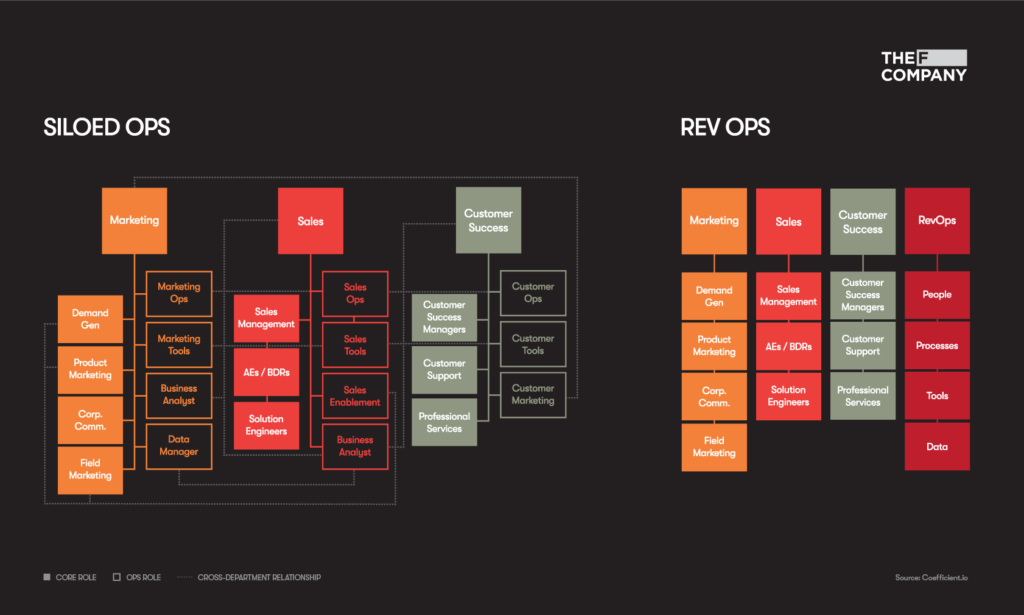Ever felt like the sales and marketing departments are playing a never-ending game of tug-of-war? You’re not alone. We recently surveyed Finnish B2B CMOs, and guess what? A whopping 85% confessed that sales teams often don’t want to collaborate. This issue is so big up here in the Nordics that we felt it’s time to take a deep dive into how to fix it.
Why are silos between Sales and Marketing a problem in B2B?
Chances are, if you’re reading this, you’ve had your fair share of headaches dealing with a sales team that seems to be orbiting a different planet. Maybe they don’t get the whole ‘marketing is important’ memo, don’t want to share lead quality data, or use Excel instead of the CRM.
It’s not just frustrating – it’s detrimental to business growth. Here’s why:
The B2B customer journey is a complex maze. The marketing team navigates approximately 95% of it, the sales team steps in for the crucial remaining 5%, and the customer success team handles upselling. To generate revenue, each team must educate and guide potential customers through this journey.

Bottom line? Growing revenue isn’t a solo gig. It’s a joint effort involving marketing, sales, and customer success.
The Revenue Operations Solution
So, how do you fix silos? There’s no perfect solution, but Revenue Operations comes pretty close.
RevOps is a function that brings sales, marketing, and customer success teams together. Instead of each team having its own tools and processes, RevOps creates a unified approach. This removes silos and creates shared responsibility over revenue.
According to a Gartner report, it’s predicted that 75% of the world’s highest-growth companies will have deployed a RevOps model by 2025. Moreover, the title of ‘Head of RevOps’ is the fastest-growing job title in the US for 2023.
RevOps is more than just a hot new trend – it’s the future of B2B marketing and sales. Here are some immediate benefits of adopting this approach:
For Marketing
RevOps simplifies the tech stack and provides marketers with access to data from other teams. This leads to better decision-making and higher lead quality.
For Sales
A RevOps Manager knows what is going on at all stages of the sales funnel, and builds a feedback loop with marketing. Salespeople can spend more time engaging with leads and closing new business, and less time blaming you for everything.
For Customer Success
When sales and marketing are in sync, customers benefit from superior content and service experience. This empowers customer success teams to upsell and renew more effectively.

How to build a lean RevOps process: 8-step guide
Creating a streamlined RevOps process is a journey that involves several key steps. From identifying operational inefficiencies to setting clear objectives, building a cross-functional team, and promoting open communication, each step plays a vital role in the overall success of your RevOps strategy. Let’s dive in and explore these steps in more detail.
1. Identifying operational inefficiencies in Sales, Marketing and Customer Success
The first step in creating a streamlined RevOps process is identifying operational inefficiencies. These inefficiencies are often hidden bottlenecks within the sales, marketing, and customer success functions that, if left unaddressed, can significantly hinder growth. By finding and addressing these inefficiencies, organizations can better optimize their revenue operations and make more strategic decisions.
2. Setting clear RevOps objectives
Once the operational inefficiencies have been identified, it’s important to set clear RevOps objectives. This step involves aligning value propositions and ensuring key data flow between the teams. By having clear, agreed-upon objectives, the teams can work towards the same goals, making the overall RevOps process more efficient and effective.
3. Building a cross-functional team
The next step is building a cross-functional team. This often involves appointing a RevOps Manager to unify efforts from sales, marketing, and customer success. Starting lean is a smart approach, and giving someone part-time responsibility for RevOps can be a practical first step before committing to a full-time hire.
4. Standardizing processes and KPIs
Standardizing processes and KPIs is a crucial step in streamlining your RevOps process. By ensuring everyone understands and strives towards revenue as the ultimate goal, you can create a unified approach to your operations. Standardized KPIs can help guide your team’s efforts and provide a clear way to measure success.
5. Aligning tools for RevOps success
Your tech stack, including CRM, automation, and analytics tools, should support your RevOps strategy. This means aligning your tools with your RevOps objectives and ensuring that they provide the insights and capabilities you need to drive revenue growth.
6. Promoting open communication
Promoting open communication is an integral part of the RevOps process. Encouraging an atmosphere of collaboration and openness can help to ensure that everyone is working towards the same revenue target. Remember, a successful RevOps strategy is a team effort that requires everyone to work together effectively.
7. Monitoring the performance of RevOps
Tracking both revenue metrics and the effectiveness of team collaboration is essential to monitoring performance. Regularly reviewing these metrics will help you understand how well your RevOps strategy is working and where adjustments may be needed.
8. Learning and improving your RevOps strategy
Finally, as with any business strategy, it’s important to continually learn and improve your RevOps approach. As you see increases in alignment and revenue, you may want to consider moving towards a full-time RevOps team. Continual learning and improvement will help ensure that your RevOps process remains effective and efficient over time.
Conclusion
RevOps isn’t some magical solution that instantly fixes all your problems. Rather, think of it as a masterful builder, diligently removing the bricks that form the walls between your teams, one by one. This change has been a long time coming, and we’re excited to be part of it.
Now, we know this might feel like a big leap, but we assure you, the potential rewards are huge. Imagine a world where your marketing, sales, and customer success teams work in harmony, fueling growth and smashing those revenue targets. That’s the power of RevOps.
Ready to make the leap and start breaking down those silos in your B2B organization? Don’t hesitate to contact us. We’re ready to guide you through the complexities of the B2B landscape and pave the way for your business to thrive.
